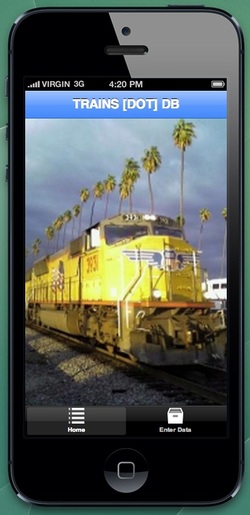 I finally settled on an app to build for my Design class! In fact, I had so much fun (hard fun!) with the first app that I built that I used a different tool to build a second one! My first app, called BabyComfort created with Appery.io was, admittedly pretty simple. I had buttons to play either a prerecorded heartbeat or a lullaby. The idea behind this was that a mother or father could use their smartphone to soothe an infant to sleep. I thought some of the enhancements could be: - Record a mother's or father's voice either reading a bedtime story or singing a lullaby.
- Recording a parent's heartbeat to play back to the baby in the crib (I read some research that stated a baby fed better when being held by their mother. . . the research was inconclusive as to whether this was the mother's heartbeat or her voice)
- Perhaps the phone's vibrate function could be incorporated to "beat" in time to the heartbeat.
- Perhaps we could even develop a plush toy of some sort with a pocket for the phone.
- And the idea even occurred to me to be able to use the phone as a crib monitor. A smart phone's audio and video capabilities might be used to broadcast to another smartphone, tablet, or computer so that a parent might monitor their child.
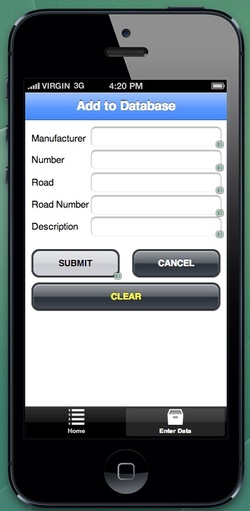 So what, you ask, does the train photo above have to do with soothing a baby? Well, . . . nothing really. That image, and the one to the left, are from the second app I built called TrainsDotDB. I used a different tool called AppArchitect for this one . . . just because I wanted to experience something something different. TrainsDotDB allows a user to collect information about a model train collection (that I happen to have). Like BabyComfort, TrainsDotDB is pretty simple, it presents a form that allows a user to enter data specific to each locomotive or rolling stock (train car). In some cases, these models can have some pretty high value, so keeping a record is essential.
So, why two apps? Well, BabyComfort, as a first endeavor, had an incredibly steep learning curve. One minute I didn't know what HTML5 was, and the next I was using it to access a database. After my, somewhat frustrating, experience with Appery.io I looked around for a different tool and found AppArchitect. This tool was MUCH easier to use but was also VERY limited in its capabilities. My takeaways? I think just about anyone with a familiarity with computers can create a phone or tablet app. The thing is, to create an app that is really useful and marketable one must have a significant knowledge of Java, HTML5, PhoneGAP, and numerous other app tools.
While neither of these was created to solve a specific problem, I did learn a lot about creating mobile apps. Like many many other things in life, scratching the surface is pretty easy, mastery however, is another story.
Well, back to square one. . . or almost. After consulting with my instructor Bill, I have come to the conclusion that making an app using image processing techniques will be far too difficult in the limited time and with my limited knowledge base. So, for this first project I am off to something different.
I have always been a big fan of black and white photography and I have owned numerous film cameras in my life from which I believe I could produce pretty good results. However, I have yet to find a decent app for shooting black and white images on my iPhone or iPad. I can’t tell you how many times I have been out and spotted a scene that I thought would make a great black and white image. I almost always have my iPhone with me but rarely carry my other camera, a Sony NEX5 which is much more suitable for black and white.
During my associates degree I learned about the Ansel Adams Zone System for black and white photography. The premise behind the zone system is that each grey scale value in a photograph should fall into one of 11 categories. Zone 0 is pure black with no detail. Zone 10 is pure white with no detail. Caucasian skin tone normally falls in zone 6 (see diagram below). I would like to create an app for my iPhone and iPad that uses a Zone System interface for black and white photography.
This app would allow a user to choose a particular section of a photo (similar to a spot meter) and lock it to one of the zones in the above diagram. For example, in the following image a user might choose an area of the screen such as the deep shadow of the mountain on the left side of the screen and lock that luminescence value to zone 3. The user could then adjust the brightness and contrast in the image to achieve the full range (if necessary) of the zones in the image. A picture could then be taken resulting in the best and most desired tonal quality in black and white on a digital device.
OK. . . . new idea! I've been working on the Cog Tools class Community of practice project. At the same time, I am working through my Action Research project to improve online student retention through the use of technology . . . and I need an idea for this design class. . . . VOILA! (or some other French adjectives). One of my postulations for online retention is the necessity of a sense of community for online students and especially for those students who are economically disadvantaged. Creating a sense of community will allow a student to build more of a sense of belonging in their online community and promote completion in their programs. So. . . in the true sense of three birds, one stone. . . I am now thinking about creating some type of technological tool to support and promote communities of practice with online students. Some type of CoP support tool. Could be a website, an app of some sort or something else. . . . not sure yet. More research needed!
Since I discovered that my idea for a design project was "stolen" (over four years ago) I have been wracking my brain trying to come up with another one. What about turning your phone into a device that would detect proximity of objects? It could be used almost like an electronic cane for the visually impaired (it's been done). What about an app for your phone that you could enter in certain interests. The phone would detect the proximity of others with the same or similar interests. A little like a community of practice facilitator (it's been done). Maybe an app that would lull a baby to sleep (it's been done). Perhaps an app for tutoring? A user could enter any question and a subject matter expert on the other end could help (it's been done).
Quoting Punch magazine from the late 1800s . . ."Everything that can be invented, has been invented."
Like Sisyphus pushing his rock. . . I will continue to think.
I have (had) this wonderful, amazing idea for my design project. Imagine, if you will, an app you could load on your iPhone, iPad, Android, etc. that would allow you go create a shopping list for a particular store. The app would interface with and allow you to choose from the store's product database with current pricing, quantity available, etc. Now - and here's the cool part - once you get to the store there would be a localized GPS system that would compute the most efficient path through the store, telling you to stop when you reach each product! You could also use the system for single products as you enter the store. For instance, you walk into Lowe's or Home Depot and need just one thing. . . say duct tape. You would search the app for duct tape and a map of the store would appear on your device and/or turn by turn directions on how to find the item. I would think that this would be very useful in those mega warehouse stores where I think the management purposefully understaffs so customers have to walk around for hours just trying to find one single item.
I've been messing with Garage Band for a few days on my iMac. Two words: Love it! I have never (at least I had convinced myself) been musically inclined. I can't read music, I can't play an instrument, not even an audiophile like a lot of my friends. Not that I haven't tried. I have a banjo, an acoustic guitar and an electric guitar. I even tried harmonica a few times and the only reason I don't have a piano is that it would be too expensive and too hard to move around. But I do know what music I like. Enter Garage Band. I am amazed at how easy it is to "compose" and "arrange" music from the loops provided by Apple. Almost immediately I was able to create a very pleasant melody with vocals, drums and piano. I surprised myself. I am continuing to play and will (maybe) post my "song" to the forums!
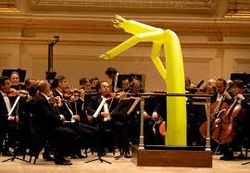 I have about as much chance of becoming a great composer as I do of becoming a train conductor. . . . read: "none". Though I have always wanted to be able to play an instrument. So that leads me to my tool tryout subject. Never played with it, never really even looked at it much but my new iMac came with something called Garage Band. Evidently I can "compose" my own music. I may end up running screaming to Drew for support but . . . . what the heck . . . I'll give it a shot.
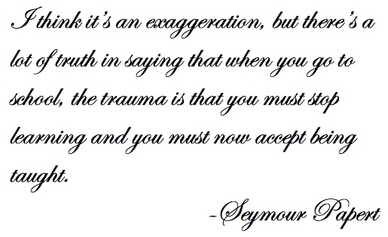 I really did, I hated high school. Looking back, I think it's because, as Papert said, I had to stop learning and accept being taught. I remember countless hours of sitting in class, bored and not learning. I know my teachers did their best, well. . . most of them did, but I just don't think they were equipped to manage every learning style. They seemed to be fine with those students who were interested and wanted to learn. I just wanted to get back home to, what I now know was, my MakerSpace. I remember my imagination being a fluid thing, dreaming up all sorts of interesting things to keep my body and brain active. This was something that school, particularly high school failed to do. It failed to motivate me to be hungry for the knowledge like I now see is possible from reading Invent to Learn. I wonder where I might be now if I had had the opportunity to go to high school every day and be curious, inquisitive, and building - rather than sitting and learning.
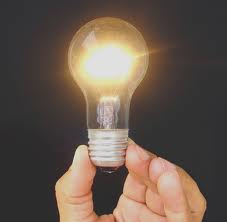 OK. . . just because I can I am going to share my Maker side as it manifested itself later in life. in 1988 I built a houseboat on a surplus US Navy Landing Craft. You've seen the old WWII movies with the boat that pushes up on the beach and the front door comes down and all these military guys come out? That's the landing craft I built a houseboat on. It's still floating around Santa Barbara somewhere. Between 1998 and 2000 I built a self-contained computer training classroom inside a semi-trailer. Yup. Heated, air conditioned, with a 25 kilowatt generator, complete ethernet network, servers, the whole works. When I started building it, computer classrooms were not easily available, nor inexpensive to rent. By the time I finished it, a laptop could be had for less than $1000. I never did get to use it for computer training. Still have it if you're interested in a 28 foot semi-trailer - cheap
The point is. . . that I am a Maker (caps intended). I have never really thought of myself as such. . . but that was before I started reading Invent to Learn by Martinez and Stager. I have always been so. As long as I can remember. The thing is that I never associated my passion with building with learning. I do now.
|







 RSS Feed
RSS Feed